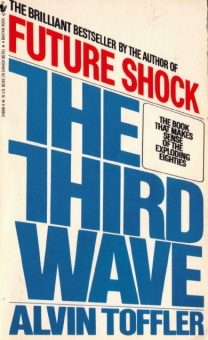THE CRACK-UP OF THE NATION
All such developments—the new economic problems, the new environmental problems, and the new communications technologies— are, converging to undermine the position of the nation-state in the global scheme of things. What’s more, they come together at precisely the moment when potent new actors appear on the world scene to challenge national power.
The best-publicized and most powerful of these new forces is the transnational or, more commonly, the multinational corporation.
What we have seen in the past 25 years is an extraordinary globalization of production, based not merely on the export of raw materials or finished manufactured goods from one country to another, but on the organization of production across national lines.
The transnational corporation (or TNC) may do research in one country, manufacture components in another, assemble them in a third, sell the manufactured goods in a fourth, deposit its surplus funds in a fifth, and so on. It may have op-crating affiliates in dozens of countries. The size, importance, and political power of this new player in the global game has skyrocketed since the mid-1950’s. Today at least 10,000 companies based in the non-communist high-technology nations have affiliates outside their own countries. Over 2,000 have alliMates in six or more host countries.
Of 382 major industrial firms with sales over $1 billion, fully 242 had 25 percent or more “foreign content” measured in terms of sales, assets, exports, earnings, or employment. And while economists disagree wildly on how to define and evaluate (and therefore classify and count) these corpora-lions, it is clear that they represent a crucial new factor in the world system—and a challenge to the nation-state.
To glimpse their scale, it helps to know that on a given day In 1971 they held $268 billion hi short-term liquid assets. ‘I’Iiis, according to the International Trade Subcommittee of I ho United States Senate, was “more than twice the total of nil international monetary institutions in the world on the »»mo date.” The total annual U.N. budget, by comparison, i« i > resented less than 1/268 or 0.0037 of that amount.
320
Pages: 1 2 3 4 5 6 7 8 9 10 11 12 13 14 15 16 17 18 19 20 21 22 23 24 25 26 27 28 29 30 31 32 33 34 35 36 37 38 39 40 41 42 43 44 45 46 47 48 49 50 51 52 53 54 55 56 57 58 59 60 61 62 63 64 65 66 67 68 69 70 71 72 73 74 75 76 77 78 79 80 81 82 83 84 85 86 87 88 89 90 91 92 93 94 95 96 97 98 99 100 101 102 103 104 105 106 107 108 109 110 111 112 113 114 115 116 117 118 119 120 121 122 123 124 125 126 127 128 129 130 131 132 133 134 135 136 137 138 139 140 141 142 143 144 145 146 147 148 149 150 151 152 153 154 155 156 157 158 159 160 161 162 163 164 165 166 167 168 169 170 171 172 173 174 175 176 177 178 179 180 181 182 183 184 185 186 187 188 189 190 191 192 193 194 195 196 197 198 199 200 201 202 203 204 205 206 207 208 209 210 211 212 213 214 215 216 217 218 219 220 221 222 223 224 225 226 227 228 229 230 231 232 233 234 235 236 237 238 239 240 241 242 243 244 245 246 247 248 249 250 251 252 253 254 255 256 257 258 259 260 261 262 263 264 265 266 267 268 269 270 271 272 273 274 275 276 277 278 279 280 281 282 283 284 285 286 287 288 289 290 291 292 293 294 295 296 297 298 299 300 301 302 303 304 305 306 307 308 309 310 311 312 313 314 315 316 317 318 319 320 321 322 323 324 325 326 327 328 329 330 331 332 333 334 335 336 337 338 339 340 341 342 343 344 345 346 347 348 349 350 351 352 353 354 355 356 357 358 359 360 361 362 363 364 365 366 367 368 369 370 371 372 373 374 375 376 377 378 379 380 381 382 383 384 385 386 387 388 389 390 391 392 393 394 395 396 397 398 399 400 401 402 403 404 405 406 407 408 409 410 411 412 413 414 415 416 417 418 419 420 421 422 423 424 425 426 427 428 429 430




